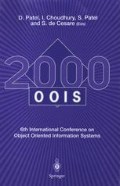Abstract
When we model a phenomenon we apply a perspective on the phenomenon. The perspective decides which properties we include in the model. It also decides how we conceive a phenomenon in terms of its constituent parts. Several perspectives on the same phenomenon create several distinct, but overlapping models. The models of the phenomenon use potentially shared parts. Their combination is a complex aggregate. The objective of this article is to investigate a conceptual model behind several perspectives and the resulting complex aggregate, and to illustrate various techniques for representing perspectives and complex aggregates as usual object models. We present a number of extensions to common modeling techniques at the conceptual level, and we discuss shortcomings and weaknesses of implementation techniques based on the object model.
This research was supported in part by the Danish Academy of Technical Sciences, EF627.
Access this chapter
Tax calculation will be finalised at checkout
Purchases are for personal use only
Preview
Unable to display preview. Download preview PDF.
References
S. Abiteboul, A. Bonner. Objects and Views. Proceedings of SIGMOD, Denver, 1991 (SIGMOD Record 20(2):239–247)
D. Bardou, C. Dony. Split Objects: a Disciplined Use of Delegation within Objects. Proceedings of Conference on Object-Oriented Programming Systems, Languages and Applications, 1996.
G. Booch. Object Oriented Analysis and Design with Applications. Benjamin/Cummings, 1994.
G. Booch, J. Rumbaugh, I. Jacobson. The Unified Modeling Language User Guide. Addison-Wesley, 1999.
L. K. Bækdal. ShipDesign Requirements. Odense Steel Shipyard, August 1997.
L. K. Bækdal. Configurable Autonomous Objects: Constraint and Framework Modelling. Ph.D. dissertation, University of Southern Denmark, Odense University, 1999.
B. Carré G. Comyn. On Multiple Classification, Points of View and Object Evolution. In Artificial Intelligence and Cognitive Sciences, Manchester University Press, 1988.
B. Carré, J. M. Geib. The Point of View notion for Multiple Inheritance. Proceedings of European Conference on Object-Oriented Programming/ Proceedings of Conference on Object-Oriented Programming Systems, Languages and Applications, 1990.
E. Gamma, R. Helm, R. Johnson, J. Vlissides. Design Patterns: Elements of Reusable Object-Oriented Software. Addison Wesley, 1994.
W. Harrison, H. Ossher. Subject-Oriented Programming (A Critique of Pure Objects). Proceedings of the Conference on Object-Oriented Programming Systems, Languages and Applications, 1993.
B. Henderson-Sellers. Open Relationships — Compositions an Containments. Journal of Object-Oriented Programming, 1997.
G. Kiczales, J. Lamping, A. Mendhekar, C. Maeda, C. Lopez, J. Loingtier, J. Irwin. Aspect-Oriented Programming. Proceedings of European Conference on Object-Oriented Programming, Lecture Notes in Computer Science, vol. 1241, Springer Verlag, 1997.
B. B. Kristensen. Object-Oriented Modeling with Roles. Proceedings of the 2nd International Conference on Object-Oriented Information Systems, 1995.
B. B. Kristensen, K. Østerbye. Conceptual Modeling and Programming Languages. Sigplan Notices, 29(9), 1994.
B. B. Kristensen, K. Østerbye. Roles: Conceptual Abstraction Theory & Practical Language Issues. Special Issue of Theory and Practice of Object Systems on Subjectivity in Object-Oriented Systems, 1996.
O. L. Madsen, B. Møller-Pedersen, K. Nygaard: Object Oriented Programming in the Beta Programming Language. Addison Wesley 1993.
J. J. Odell. Six Different Kinds of Composition. Journal of Object-Oriented Programming, 1994.
Rational. UML v.1.1. http://www.rational.com.
T. Reenskaug, E. P. Andersen, A. J. Berre, A. Hurlen, A. Landmark, O. A. Lehne, E. Nordhagen, E. Ness-Ulseth, G. Oftedal, A. L. Skar, P. Stenslet. OORASS: Seamless Support for the Creation and Maintenance of Object Oriented Systems. Journal of Object-Oriented Programming, 1992.
J. Rumbaugh. Relations as Semantic Constructs in an Object-Oriented Language. Proceedings of the Object-Oriented Programming Systems, Languages and Applications Conference, 1987.
J. Rumbaugh, M. Blaha, W. Premerlani, F. Eddy, W. Lorensen. Object-Oriented Modeling and Design. Prentice Hall 1991.
B. Stroustrup: The C++ Programming Language. 2/E, Addison-Wesley 1991.
M. E. Winston, R. Chaffin, D. Herrmann. A Taxonomy of Part-Whole Relations. Cognitive Science, 1987.
Author information
Authors and Affiliations
Editor information
Editors and Affiliations
Rights and permissions
Copyright information
© 2001 Springer-Verlag London Limited
About this paper
Cite this paper
Bækdal, L.K., Kristensen, B.B. (2001). Perspectives and Complex Aggregates. In: Patel, D., Choudhury, I., Patel, S., de Cesare, S. (eds) OOIS 2000. Springer, London. https://doi.org/10.1007/978-1-4471-0299-1_6
Download citation
DOI: https://doi.org/10.1007/978-1-4471-0299-1_6
Publisher Name: Springer, London
Print ISBN: 978-1-85233-420-8
Online ISBN: 978-1-4471-0299-1
eBook Packages: Springer Book Archive

